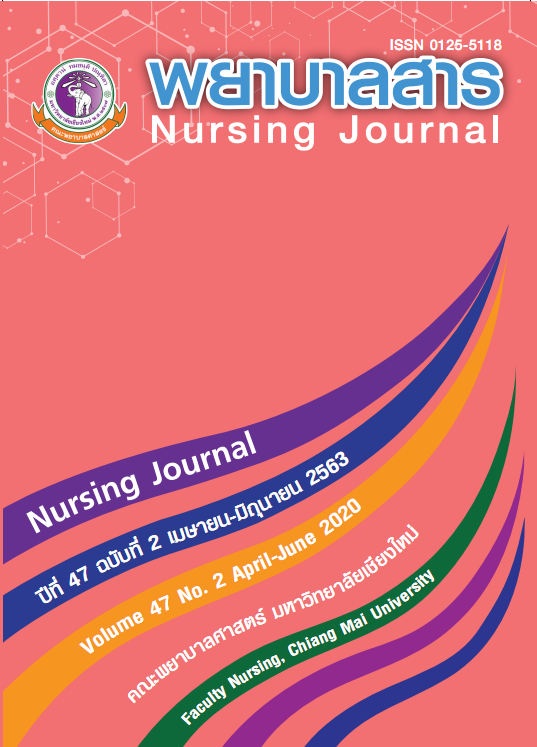Food Consumption Behaviors, Fruits and Vegetables Among School-aged Children in Chiang Rai Province
Keywords:
access to food source, food consumption behavior, eating vegetables and fruits, school-aged childrenAbstract
Appropriate food consumption behaviors, eating enough fruits and vegetables, and access to food sources are important factors to nutritional status and well-being of school-age children. This research aimed to explore food sources and eating vegetables and fruits of school-age children in Chiang Rai Province. The samples were 1,467 students under Chiang Rai Provincial Primary Education Office. They studied in 1st semester academic year 2018. Stratified random sampling was used to collect data. Data were collected by a food consumption behavior, eating vegetable and fruit tool (semi-Food Frequency Questionnaire; semi-FFQ). The reliability of the instruments was .96. Data were analyzed using descriptive statistics.
The results revealed that:
- 54.1 percent of the samples were outside the municipality. Food sources that were most easily accessible were community stores. Additionally, the sources of main food were markets.
- Students had food consumption behaviors in high frequencies and quantities as follows: High-sugar foods such as desserts that made from egg yolks as 16.0% and sweet-brewed beverages as 14.2%. High-sodium foods were instant noodles as 45.9% and processed meat as 40.1%. High-fat foods were fried eggs as 51.0%, omelets as 50.1%, and fried porks, fried meats and fried fishes 49.6%. High fat and sugar were coconut milk or milk ice creams 38.6%. High fat, sugar and sodium foods were crunchy snacks 60.4% and fast foods 12.8%.
- Eating vegetables and fruits found that students had eating behaviors in high frequencies and quantities as follows: The most were cooked vegetables 34.0%. The followings were vegetables used with fruits, tubers, and roots such as tomatoes, carrots and pumpkins 26.8%. Seasonal fruits such as rambutans, mangosteens, and oranges were 28.7%, and local fruits such as papayas and bananas were 23.4%.
The results of this study will be important information in planning and developing policies and various projects for students in order to have nutritional status according to the criteria and continue to achieve well-being.
References
Aongard, W., & Pinyoanunthapong, S. (2016). Consumption of children early childhood education in the schools under the Bangkok Metropolitan Administration. Journal Forum of Education, 17(1), 13-27. (In Thai)
Akepalakorn, W. (2014). Thai Health Survey by Physical Examination #5 2014. Nonthaburi:Health Systems Research Institute. (In Thai)
Bureau of Nutrition Department of Health. (2018). Annual Report, 2018. Retrieved from http://env.anamai.moph.go.th/download/actionplan/reportEB4_210261.pdf (In Thai)
Bureau of Health Promotion Department of Health, Ministry of Public Health. (2014).Annual Report Department of Health. Nonthaburi: Department of plans. (In Thai)
Bereau of Health. (2014). Manual training course to develop the master school children”,Nonthaburi : The Department of Health, Ministry of Public Health. (In Thai)
Chotibang J., Namprom N., & Worakidpoonpol, P. (2012). Effect of Empowerment Program on Eating Behavior and Physical Activity among Overweight Children. Nursing Journal, 39(1),23-34. (In Thai)
Chiangkhuntod, S., Mutthawangkul, C., & Junjarean, K. (2014). Research reports about the knowledge and food consumption of People in Pasri Charoen. Retrieved from http://rcfcd.com/wp-content/uploads/2014/03/9_สุวรรณา_รวมเล่ม.pdf (In Thai)
Office of the Basic Education Commission Chiang Rai. (2018). Basic information to the Office of the District area of study elementary school Chiang Rai. Retrieved from https://www.obec.go.th/ (In Thai)
Jaicherdchoo, R., Udomvong, N., & Boonchieng, W. (2013). Development of a Community Participative program for Health Promotion among overweight student. Nursing Journal,40(2), 64-76. (In Thai)
Jaikumwang, N. (2015). Risk behaviors of the group at risk of diabetes and high blood pressure:A Case Study of the hospital health promotion, Tambon Pakkayang, Sukhothai Province.The Official Journal of the community development and quality of life, 3(2), 173-184. (In Thai)
Jantharungsri, P. (2015). Knowledge attitudes and behaviors of Vegetables of the students in grades 4-6 School Queen (Master’s thesis, University of Rajamangala Phra Nakhon). (In Thai)
Kaeocha, A., Tunpiphat, A., & Witthayaprichakun, P. (2004). Consumption behaviors and factors Influencing the purchase Instant noodles in Bangkok. The agricultural journals King, 22(3),1-10. (In Thai)
Kitchanapaibul, S., Klunklin, S., & Klunklin, A. (2013). The effectivess of a health education program by applying the self-efficacy theory on eating behavior of late primary school students with overweight condition at the basic education expansion in chiang kham,phayao province. Nursing Journal, 40(2), 77- 87. (In Thai)
Kongla, M., & Kunaratthapruk, K. (2012). Consumption of vegetables and fruits and vegetables in folk of students early teens in rural amphoe si that Udon Thani Province. The KKU Research Journal, 12(1), 66-79. (In Thai)
Kriengsinyos, W. (2014). Eat the fruit and vegetables. 400 g per day to better health, The documentation for academic meeting National Food and Nutrition for health 1#. Bangkok:Mahidol University. (In Thai)
Phenphong, M. (2016). Food consumption of the group the students and students in Surat Thani Province. The Journal of science, 3(1), 109-26. (In Thai)
Pongautha, S. (2018). Project the behaviors of fruit and vegetables, risk to health and nutrition in the area under the project plan food to health condition. Retrieved from http://www.fhpprogram.org/media/pdfs/reports/471878b3f85b3cbf1c3d27300ce78890.pdf (In Thai)
Strategic Department and Information Chiang Rai Province. (2018). General Information ofChiang Rai Province. Retrieved from http://www.chiangrai.net/cpwp/?page_id=145 (In Thai)
The National Statistical Office. (2014). To explore food consumption of the population in 2013.Bangkok: National Statistics Office. (In Thai)
Unicef. (2006). Thailand Multiple Indicator Cluster Survey December 2005-May 2006.Retrieved from http://planning.anamai.moph.go.th/download/D_DataMarts/MICS/MICS3_2548-2549.pdf
Zakai, Y., & Sutha, W. (2018). Knowledge attitudes and behaviors of fruit and vegetables of the students at the beginning of the school to demonstrate the following universities:eco-friendly interface (high school). Veridian e-journal silpakorn university, 11(3), 1038-1055.(In Thai)
Downloads
Published
How to Cite
Issue
Section
License
บทความที่ได้รับการตีพิมพ์เป็นลิขสิทธิ์ของวารสารพยาบาลสาร
ข้อความที่ปรากฏในบทความแต่ละเรื่องในวารสารวิชาการเล่มนี้เป็นความคิดเห็นส่วนตัวของผู้เขียนแต่ละท่านไม่เกี่ยวข้องกับมหาวิทยาลัยเชียงใหม่ และคณาจารย์ท่านอื่นๆในมหาวิทยาลัยฯ แต่อย่างใด ความรับผิดชอบองค์ประกอบทั้งหมดของบทความแต่ละเรื่องเป็นของผู้เขียนแต่ละท่าน หากมีความผิดพลาดใด ๆ ผู้เขียนแต่ละท่านจะรับผิดชอบบทความของตนเองแต่ผู้เดียว






